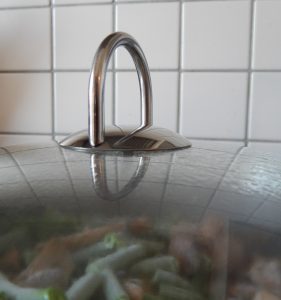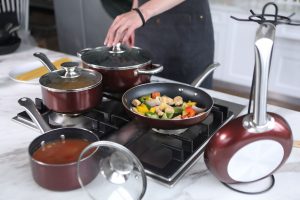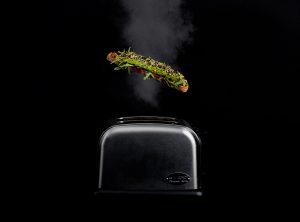Saving energy with our cooking hacks – it’s so easy!
Cooking for yourself is fun, healthy and, in most cases, much cheaper than going to a restaurant every day. However, as we well know, energy costs are on the rise so it’s worth taking a closer look at your cooking habits – with just a few tips and tricks, you can easily reduce the energy you use when cooking.
Around 10% of total household electricity consumption is attributable to cooking in the home. Yet there are plenty of ways to pinpoint any item that is wasting energy in the kitchen and therefore not only save money but also do something good for the environment. Whether that is choosing the right kitchen items, the right appliance settings or other clever tricks – it can be incredibly easy to save energy and start sustainable cooking.
7 tips for energy-saving cooking
The following seven tips are designed to help you cook in an energy-efficient manner:
1. There’s a lid for every pot
This phrase hits the nail on the head: There’s a lid for every pot. And while you may not agree with this adage in its romantic context it is certainly true in the kitchen. Bringing 1.5 litres of water to boil with a lid saves around 65% of electricity or gas. And not only that, but the whole process goes three times faster too. Another added bonus is that your food is ready sooner, rather than wasting your precious free time in the kitchen. It’s also a good idea to use glass lids, as you’ll always be able to see exactly what’s going on, and you’ll rarely have to lift the lid to check and lose heat unnecessarily.
And of course, the pot is just as important as the lid! Make sure that your cooking pot is a good fit for the size of the hob. A pot that is too small for the hob wastes energy unnecessarily and one that is too large prolongs the heating process. And always remember to choose the smallest possible cooking pot for each meal, as it will heat up faster – again saving energy and time.
2. Try to do without preheating and use residual heat
For many products, it is recommended to preheat the oven. However, this is often not necessary, and you can put your dishes directly into the oven without a second thought. This may extend the cooking time a little but it also saves a lot of energy. Another tip: Switch the oven off five to ten minutes before the end of the cooking time. The residual heat in the oven is usually enough to finish the dish. The same applies to the hob – here, too, you can turn off the hob earlier to save energy while cooking and the water will still continue to boil.

3. Using the correct cookware
While it is indeed true that not do not need to replace everything that is old, it is also a fact that old or defective cookware can quickly lead to energy losses. If the bottom of the cookware is uneven and no longer flat, energy is lost during heat transfer. Furthermore, new pots and pans allow cooking with less energy because they retain heat for longer. 
The right baking trays and baking tins can also help you with energy-efficient cooking. Items that are enamelled or painted black are particularly efficient at absorbing heat. In addition, baking trays and grids that are not needed should be removed from the oven, as they heat up unnecessarily and mean that energy is lost.
4. Heat the oven with circulating air instead of top/bottom heat and keep the door closed
If you have the option of choosing between convection and top/bottom heat in recipes, it is best to always opt for convection. This allows you to save up to 40% of energy when cooking. In addition, the temperature can be set about 30 degrees lower and several trays can be baked at the same time.
Even if the aroma coming out of the oven is tempting – it is best to keep the door closed during the entire cooking time. Every time you open the oven door, about 20% of the heat is lost. As a result, the oven has to heat up more and more energy is needed.
5. The many uses of the humble kettle
Use the kettle not only for making tea, but also for eco-friendly cooking. Instead of heating the water in a pot, use the kettle. This can save 50% of electricity consumption when compared to the electric stove. And be mindful to only use only as much water as you need, which not only saves energy but also saves water and time.
6. Microwave small meals
If you want to heat a dish for one person or heat drinks and snacks, it is more energy-efficient to use the microwave instead of the stove. However, for larger quantities of over 1 kg/1 litre, we recommend the stove top or the oven.
7. Bakery fresh rolls…well almost!
Bread rolls left over from the day before get a new lease of life when briefly warmed up. But don’t use the oven for this, heat them up on the warming rack of the toaster. This will save you up to 50% of the energy!
With these simple tips and tricks, it is possible to greatly reduce energy consumption in the kitchen, so you have a little less to worry about in the face of rising energy costs.

Cooking in a more energy-efficient way – a brief overview of all seven tips
- Always cook with lids on and choose pots that fit the hob as precisely as possible.
- Do not preheat the oven and turn it off a few minutes earlier to make use of the residual heat.
- Look for energy-efficient cookware with even bottoms.
- Set your oven to convection more often and refrain from opening the door as much as possible.
- Use only as much water as necessary and boil it using the kettle rather than on the hob.
- Smaller meals can be heated in the microwave in a more energy-efficient way
- Make yesterday’s bread crispy fresh again by using the warming rack on the toaster instead of the oven
Green cooking is good, but the refrigerator also offers some opportunities to save electricity and money. Find out the Liebherr refrigeration technologies to save energy. Using energy-efficient appliances is your next step.